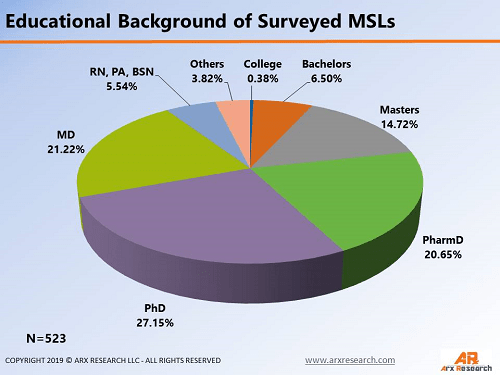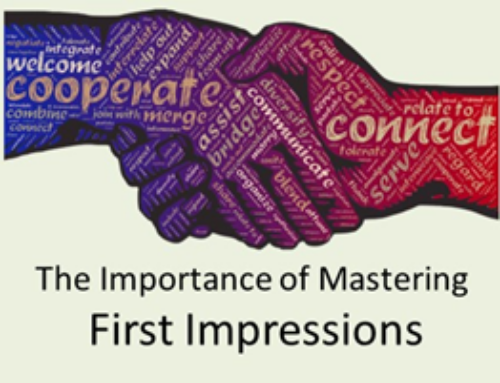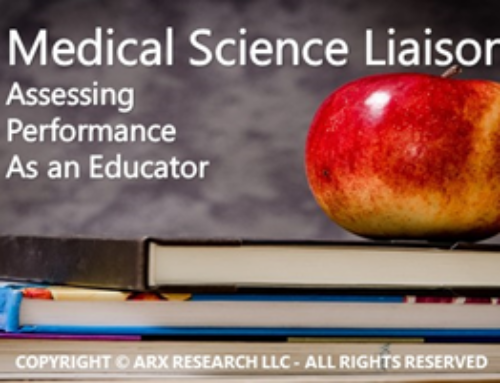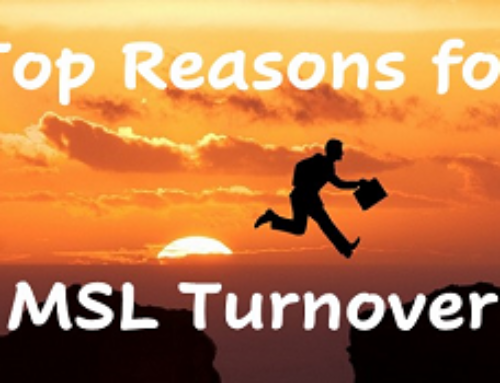Are you wondering how to become a Medical Science Liaison (MSL)? A MSL connects life science organizations to industry thought leaders (or KOLs) by sharing scientific and clinical information on products and involving these KOLs in research, speaking or consulting activities. Here’s what you can expect from your journey of medical science liaison training and preparation.
Choose Your Area of Expertise
Most MSLs have graduated with a doctorate degree (PhD) and many have PharmD education (figure below). But there are several different routes that you can travel within your pharmacological studies to arrive at being a Medical Science Liaison. It really all depends on what area you wish to focus on and specialize in. There are many therapeutic areas to choose from as you progress through your medical or pharmacy school education. It’s up to you to decide which area you’d like to dive into. Make your realm of expertise once you are ready to make the transition to a Medical Liaison.
Be Aware of Key MSL Metrics
Preparing to be a MSL also involves understanding what the role entails and how organizations will measure your performance. We have put together a toolbox report that will help you better grasp your objectives as a Medical Science Liaison here (key metrics for MSLs). These findings stem from our extensive research on the role and the Medical Affairs function, where MSLs operate and report into. It is imperative for new and existing MSLs to learn how their contribution will be assessed and how they could make a beneficial impact to the organization.
Hit Your Educational Goals
Over time, those who want to become a Medical Science Liaison have found it more and more difficult. It requires higher levels of experience and expertise in order to do well. Some liaisons can get an MSL position with a Masters degree, but most positions require a minimum of a PhD in the area of medical expertise that a company or product requires. The graphic below shows the educational background of several hundred MSLs surveyed through our research. Pursuing the educational route of a Medical Doctor (MD), Pharmacist (PharmD), or a doctorate level of study in either area can provide you the schooling required to pursue a career as a Medical Science Liaison.
Bolster Your Work Experience
If you want to learn how to become a Medical Science Liaison, an excellent way into this field comes down to having the right connections. It helps to know someone who can then get you started. If you don’t have that relevant connection, then you’ll need to focus on bolstering your job prospects to become a Medical Liaison based on the types of jobs you choose to pursue in the meantime. Sharpen your expertise and increase your future chances by always pursuing MSL roles that correlate with your expertise. Many MSLs come from backgrounds such as pharmaceutical sales, academic research or even practitioners. Our latest research also shows MSLs make an average $138,000/yr salary.
Also, be able to communicate that you possess key skills required to be an MSL. First research those necessary skills and know how you can clearly communicate them. If necessary, you can also join medical groups specific to becoming a Medical Science Liaison to help you network within the medical community. Medical Science Liaison training can only get you so far, but making the right connections can carry you through toward your professional goals.
Here are a few links to organizations providing specialized training for aspiring MSLs or for current MSLs looking to sharpen skills to enhance their career.
From Science to Pharma
https://fromsciencetopharma.com/
Medical Affairs Professional Society
https://www.medicalaffairs.org/
Accreditation Council for Medical Affairs (ACMA)
https://www.medicalaffairsspecialist.org/
Medical Science Liaison Association
https://msla.org.uk/







